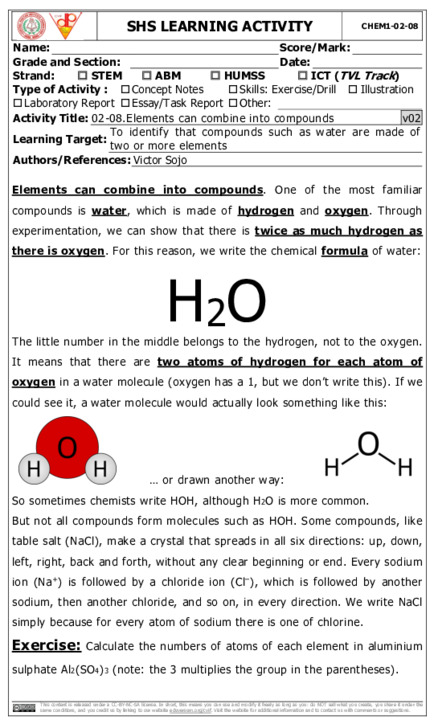Downloads
 |
 |
 |
| Download this LAS as a PDF file | Download all the Chemistry 1 LASs together in a long PDF | Download the originals as a DOCX file under the terms of our CC-BY-NC-SA license |
Purposes
- This LAS introduces compounds, by showing perhaps the most familiar of all, water.
- It also introduces chemical formulas (H2O) and structural formulas, both in 3-dimensional (spheres) and in Kekulé (stick-bond) representations.
- The Kekulé structure is meant to introduce the idea of bonds, which will be discussed in a later LAS.
- This LAS also introduces molecular shape: note that water is not drawn flat, but at an angle. The reason for this is that the oxygen atom has two lone pairs of electrons that are not shown. Since all bonds are made of electrons, they repel each other. This will be discussed later as part of a later topic on molecular shape.
- A very important purpose of this LAS is to let students know that not all compounds come in molecules. This is discussed below.
- The exercise asks students to calculate the total number of atoms of each element in the compound aluminium sulphate Al2(SO4)3. It instructs the students that the number 3 outside the parenthesis multiplies the whole group sulfate SO42–. This has the intention of introducing more complex inorganic chemical formulas, in preparation for the upcoming nomenclature and stoichiometry topics.
- Another intention of the exercise is to make students start thinking about multiple proportions (two aluminium ions for each three sulfate ions).
Answers to questions
- Al: 2, S: 3, O: 12.
- Be careful with answers such as Al2S3O12. This is wrong because it can lead to confusion: students might think that it is OK to “collapse” formulas into the simplest possible expression. Chemists do indeed do that, particularly in geochemistry and organic chemistry, but for most of inorganic chemistry it should be avoided. This is because it causes trouble with learning nomenclature and the 3-dimensional structure of compounds later on.
Discussion
- The main idea to convey is that compounds are made of atoms of two or more different elements.
- It’s important to highlight that the two atoms must be from different elements: N2, O3, P5 and S8 are all made of many atoms, but none of them is a compound. They are all elements because they are made of only the same type of atom.
- Emphasize that the number of atoms is always written next to the symbol on the left (or a closing parenthesis, like in the exercise). However, there are no spaces before the next symbol, so it looks as if it is in the middle of the two symbols. It always belongs to the atom or group to its left.
- Also important is to highlight that we don’t write the number 1. For example, sodium sulphate would be Na2SO4, without a parenthesis for the sulfate, and the students are already familiar with NaCl and H2O.
- Other compounds that students may be familiar with include table sugar (sucrose C12H22O11), table salt (sodium chloride NaCl), carbon dioxide (CO2), benzene (C6H6), sulfuric acid (H2SO4) and ammonia (NH3). Ask them if they know the formula for any of those.
- You can also ask them if they know any other compounds, and if they come up with something you don’t know (such as acetaminophen/paracetamol, aspirin, or something like that), tell them to find it out for the next class and write it on the board.
- The types of bonds in salt crystals, molecules and metal alloys will be discussed later. It is probably best if you do not go into detail here. However, it is important to briefly emphasize for the students that many compounds do not form molecules. Ions in a salt, for example, don’t form molecules (they form 3-dimensional crystal lattices, which will be discussed later in the Bonds section), and neither do metal alloys (they form a different kind of 3-D lattice, also discussed later).
- If you wish, you can very briefly introduce or mention ionic bonds (in simple inorganic salts), covalent bonds (in molecules), and metallic bonds (in alloys), but we have a later LAS for that.
- H2O, N2, NH3, C12H22O11, CO2, O3, P5 and S8 are all molecules.
- NaCl, Na2SO4 and Al2(SO4)3 are not molecules. There are no molecules of NaCl.
References and authors
References
- Brown et al. The Central Science, 14th Ed. Pearson. ISBN:978-1292221229.
Authors and contributors
This LAS was developed by Dr. Victor Sojo, with helpful contributions from Dr. Christopher Bernido and Dr. Marivic Bernido.
If you have any questions or comments, please leave them below.
